Oka Jelantik is a traditional healer in Denpasar, Bali’s capital. He uses a most vigorous, spiritual-based practice to heal the sick and uplift the afflicted. Oka is totally hands-on and chisel-up. Yes, Oka’s treatment often uses a hammer and a chisel-like instrument, (see video below) along with other home made tools. His healing method could be deemed as simply chiropractics, combined with deep tissue massage, plus using some basic wood working techniques. Yet, reducing Oka’s healer to simple physical elements ignores Oka’s spiritual healing powers. He draws from some Divine power source: the totality of his healing is greater than its individual parts. This writer has used native healers world-wide. Oka’s intervention is the most intensive spiritual and physical based healing practice this writer has ever encountered. . A treatment by this man is a powerful, moving experience. Here below is Oka in action working on this writer in a therapy session:
Oka is more than a hammer swinger. He uses a whole panoply of home made tools combined with deep tissue massage, plus more. For example, Oka’s hands-on therapy may be topped off with herbal treatments for patients to take at home. Yes, the treatment can induce the whole gamut of patient response from relaxation to intense physical pain. This writer has life-long skeleton-muscular problems, including chronic back pain. It was no surprise that Oka’s treatments were painful at first. Over the course of periodic treatments, the treatments were always of the same intensity. Yet, the patient’s (this writer) subjective pain level was greatly reduced as his conditions improved over time. The writer is now pain-free with increased mobility and movement, largely thanks to Oka.
Background: Traditional Healers are Ancient Craftsmen with Modern Success
Traditional healers of all kinds exist throughout the world. The modern world can easily scoff at traditional healing as misguided at best, and witchcraft at worst. Never dismiss the native doctors whose treatment plans fall out of the realm of “rational” medical practice. These so called “barefoot doctors” have an impressive array of healing techniques involving tried and true traditional practices that work. The array of traditional healing methods varies by country and culture.No matter what potion is ingested or trance induced, all traditional healing shares some common threads. The native healing is rooted in the traditional culture and beliefs, and sometimes predate ”modern religion” (example, Buddhism, Christianity or Islam) or may incorporate some of these newer, organized religions. The healer serves as a curative link between God(s) and man. Remember: if you feel, you heal.
The varieties of healing experiences including native practitioners who heal directly with their mental and spiritual powers. They use what Westerners might call “talk therapy”, or empathetic discussions; or perhaps, even telepathic mental suggestions, (maybe). However, many traditional healers ramify their mental treatments by using one or more of a great variety of curative interventions. The range of healing techniques is as varied as the human experience. For example, some healers throw bones, others may invoke magic rituals, some engage in rhythmic breathing, or dance, many contact the Divine directly, or draw on crystal energy, or invoke the whole range of smells and bells (incense, smoke, whistles, bells, chants, ululations and the like.) The curative arsenal includes herbal remedies, poultices, or other lotions and potions. Many of these meds have potent healing powers, if used correctly following native wisdom. Some healers send patients on a quest, or direct the sick to take other affirmative actions. And do not forget the psychic surgeons of the Philippines and elsewhere, including Indonesia, whose job title says it all about their healing techniques. These traditional doctors perform surgery without scalpel or anesthesia. See below for a discussion and video of psychic surgery. Among this whole array of healing arts, there are practitioners who use more hands-on techniques. Their treatments are similar to massage, chiropractics or physical therapy. Oka Jelantik is one of the hands-on Bali healers, but he goes way beyond chiropractics.
Bali Healers Run the Gamut and Ride the Range
As mentioned, there are healers in every corner of the globe, and Bali is no exception. In Bali, traditional healers are called “Balians” There are at least eight different types of Balians, as set out in the article in this website, “Enter the Balians” found at: https://templesandtribes.net/test-bali-traditional-healers/
Many Balians chant mantras, apply potions or invoke rituals to cure physical or spiritually induced ailments. Yet, Bali healers go way beyond healing illness and include those practitioners who specialize in setting broken bones, for example. Other Balians can find lost objects, identify unknown both thieves or scoundrels practicing black magic against the patient; and even healers who communicate with the dead. This writer has written about his experiences with such Balians elsewhere in this website including the article cited above and one other main article, “Balians Part II” found at https://templesandtribes.net/balians-part-ii-traditional-healers-and-bali-culture/
In Bali, there are two fountainheads of learning that people draw on to become traditional healers. Some practitioners learn their healing arts at school and from books. If they have a challenge or become unsure, the educated Balians can pull out a manuscript or consult with their former teachers for guidance. The other type of healers rely on their own talents that are either intuitive, or come directly from God(s). They have no formal training, no hoary manuscripts to fall back on in time of uncertainty. Their healing powers comes directly from the sacred. At first blush, Westerners commonly think that the best Balians are those with standardized training, an academic background, the healers who can consult with manuscripts or former teachers. Wrong. Traditional healing is not best suited for a diagnostic or statistical manual, or formal academic training. Balians do not heal by number. Generally, the “uneducated” healers, the so called “self-taught” doctors are the most powerful practitioners. Their skills come from their innate talents, or perhaps direct from a higher power. This writer always seeks out healers who have a calling direct from the Divine. That is where the healing power lies.
Oka Jelantik Has a Direct Line to the Source
Oka is one such spiritually intuitive healer. Oka’s healing arts are gifts from the Divine. Okay was born and raised in a small village about forty five minutes outside of Denpasar, the capital of Bali. After high school, he bounced around and had many jobs. At one point, Oka crossed paths with a local oracle and healer. In the course of treating Oka, the healer told Oka that he had gifts of healing and would be called to serve others. Oka pondered this prediction thinking that perhaps the oracle was mistaken. Oka went about his life working a number of jobs including tour guide and taxi driver in Bali. He eventually got an offer to go to the U.S.A. He spent three years working and traveling in America. Oka’s longest stay was, oddly enough, ouside of Boise, Idaho (an isolated region of middle America) where he worked as a white-water rafting guide. Oka eventually returned to his home village of Bali. He was at a crossroads of this life and work, not sure what direction to take.
One day, in his home village, Oka sat on a riverbank meditating. The world around him swirled like it was being sucked into a funnel. Starting slowly with increasing vividness, Oka peered into his future. He had a vision and message that it was time. It was time for him to begin his journey as a healer. As he left the riverbank, Oka stopped to pick up an odd shaped piece of driftwood. He sensed it had a purpose. Oka took the wood home pondering until he saw its true form. The scrap wood could be shaped into a healing wedge. He fashioned the wood into a tool that he still uses for muscular, energetic pain release.
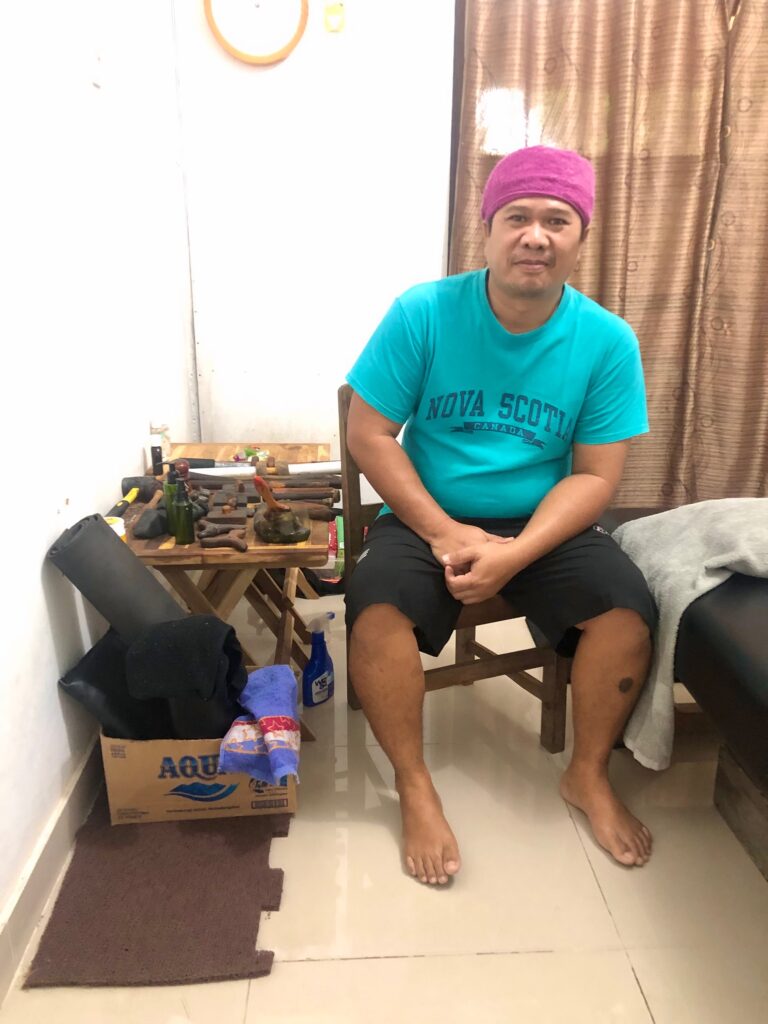
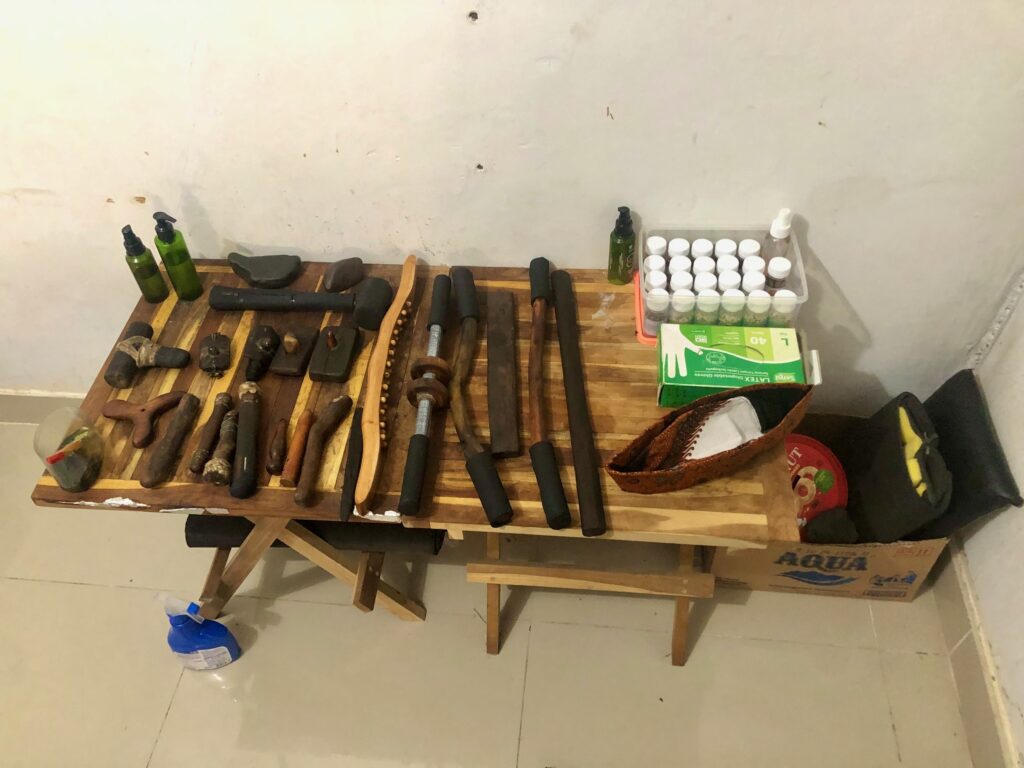
This was the beginning of Oka finding and making all of the healing tools of his trade, with one or two exceptions that are store bought. Oka began to experiment with his massaging tools that he made out of scrap wood and stones. He used these tools to help friends and family who were sick. Now, ten years later, Oka uses them in full-body treatments to heal the sick and comfort the afflicted. His specialty is migraines and vertigo but Oka treats all muscular, bone or nerve afflictions. His physical treatments are all intertwined with a spiritual treatment practice also.
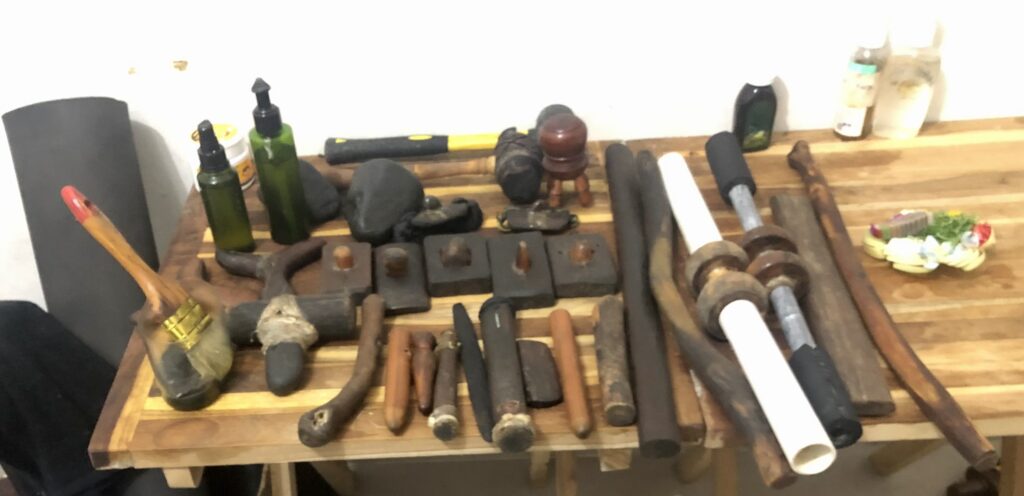
As mentioned, Oka treats a range of illness but specializes in treating migraine and vertigo or any problems related to breathing. The variety of Balians or traditional healers in Bali can treat these ailments in many different ways. Oka is a pijat, a healer who primarily uses massage therapy as the basis of healing. His clinics in Denpasar are called Pijat Migrainsp 1 and Pijat Migrainsp2. Oka is more than a back cracker and body bender. On a spiritual plane, Oka aligns patients with God and this is harder to explain or verify. Right: The sign outside of one of Oka’s clinics.
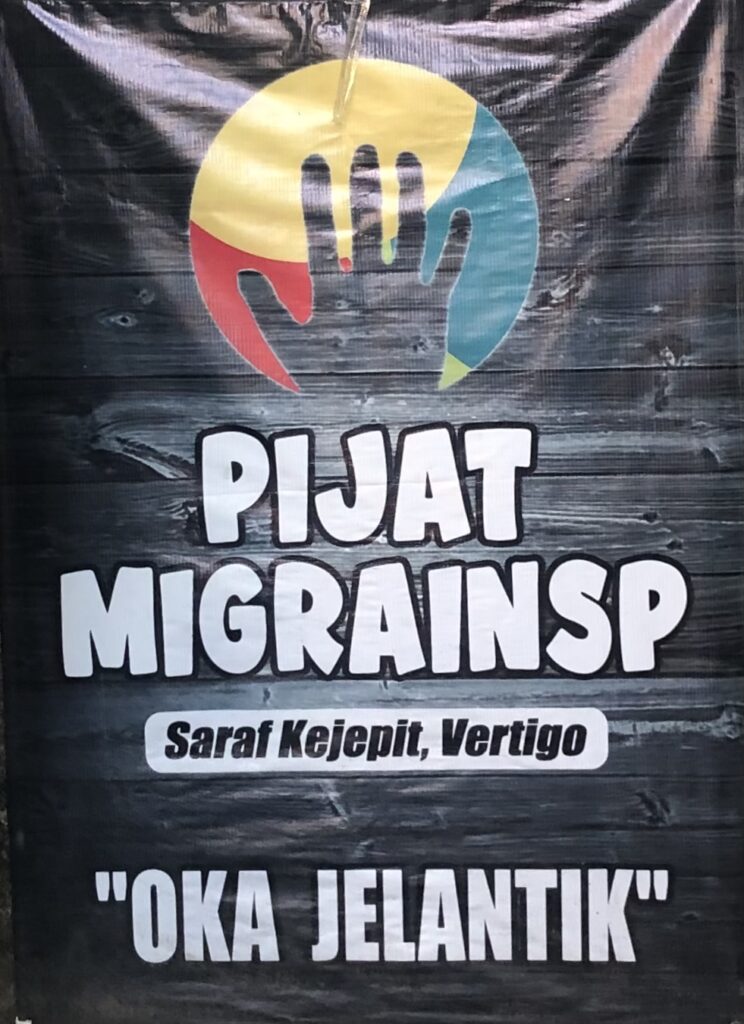
Currently, Oka operates at two clinics in the Denpasar area. Oka does have a fee schedule but he makes it real clear (for example, a notice on his signs outside of the clinic) that all fees are on a sliding scale and no one is turned away for lack of payment. This reflects Oka’s philosophy that he is enmeshed in his village and woven into greater Bali community. He serves the community and the community feeds (supports) him. And this can be literal as he even accepts chickens as payment. This attitude is also seen in how Oka lives his daily life. After touring large parts of the world and living in the U.S.A. for three years, Oka returned home to his traditional village outside of Denpasar. He currently lives in his ancestral family home with his wife and family, and the whole clan is nearby.
Traditional healing in Indonesia is a kaleidoscope of curative practices. Putting aside the more extreme treatments that are hard to understand (see bonus section below), Oka stands out as the most powerful healers. He is one of the latest and greatest Balians out there. Oka is available for treatment appointments at one of his two clinic locations in Denpasar. Contact Oka on his WhatsApp business account, Pijet Miga (Migraine Healer): +62 813 3939 7008. Oka is also on Facebook and Instagram.
Right: Photograph of Oka Jelantik and the writer, Zephyr Carlyle
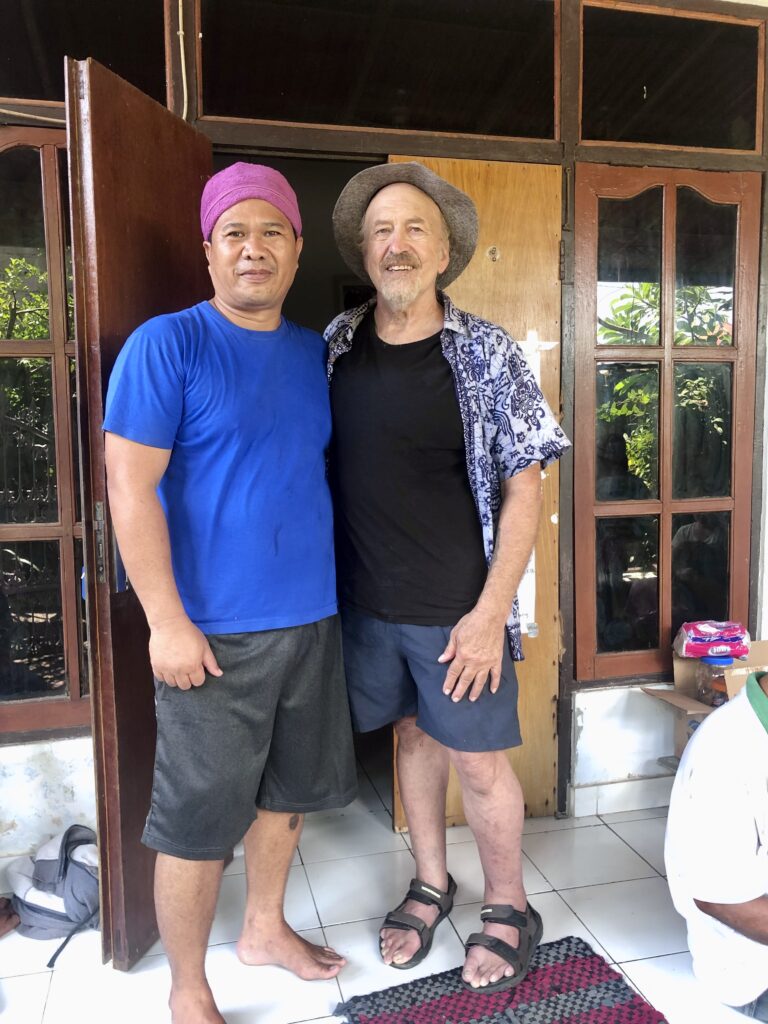
Bonus Section: Traditional Healing In Indonesia is a Coat of Many Colors
The range of healing options in Indonesia is stunning. This article highlighted the intense and very focused healing work of Oka Jalantik. However, Indonesia has native doctors in all shades of the healing color wheel. For example, aside from the eight kinds of Balians just in Bali alone, Indonesia also has psychic surgeons. The work undertaken by psychic surgeon is fully encapsulated in their job title, but it is a head scratcher. Philllipines is famous for its psychic surgeons, but they also exist in Indonesia.
And Indonesia has other native remedies that are clearly in the ”say what?” category of healing arts. One example are the patients who undertake self-induced electroshock therapy. People seeking this cure simply go to the nearby train station. They sit on the electrified third rail of the train tracks. The patients wait for the passing train to light them up with healing energy. For more details, see the article on this website “Enter the Balians: The Eight Kind of Traditional Healers” with the link set out above.
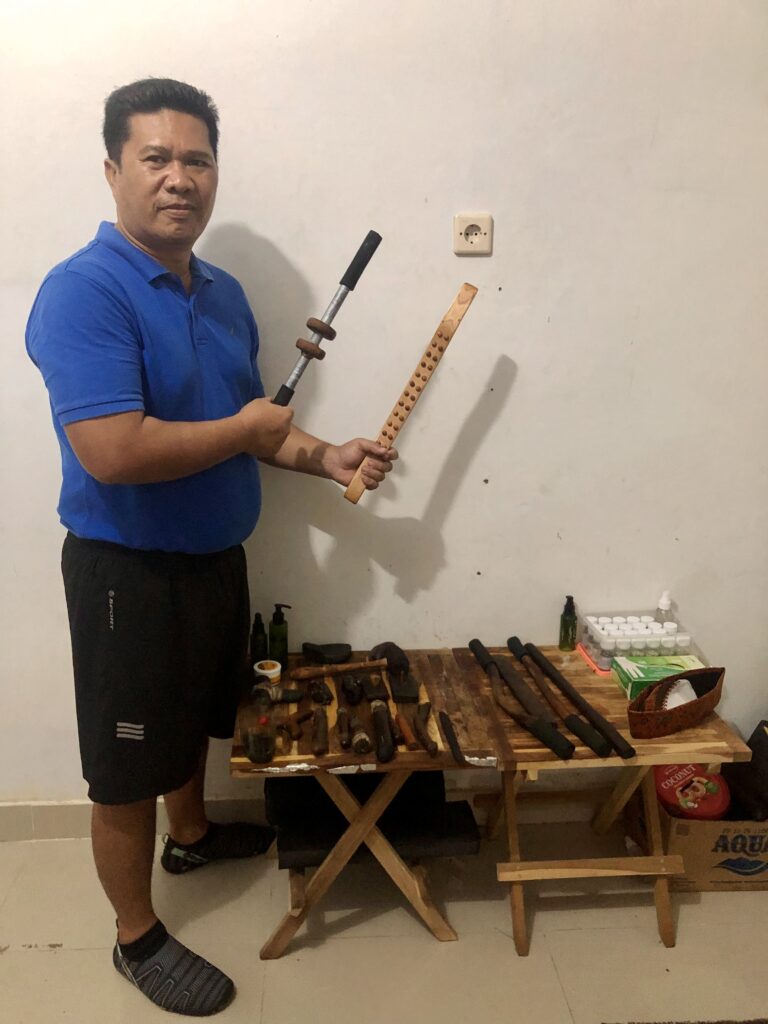
I read through your article twice. I have been treated by curanderos in Mexico and am fascinated by your description of traditional healing in Bali.
I stole a couple of your metaphors for use in the stuff I’m writing about Saint Paul. He was a faith healer. I agree with your judgement that traditional healing works best when the healer is in communication with the divine.
Great article.
I await more of your writing.
ROSS rgandy1102@gmail.com
Holy crap that looks painful. Reminds me of “it feels so good when I stop banging my head against the wall”.